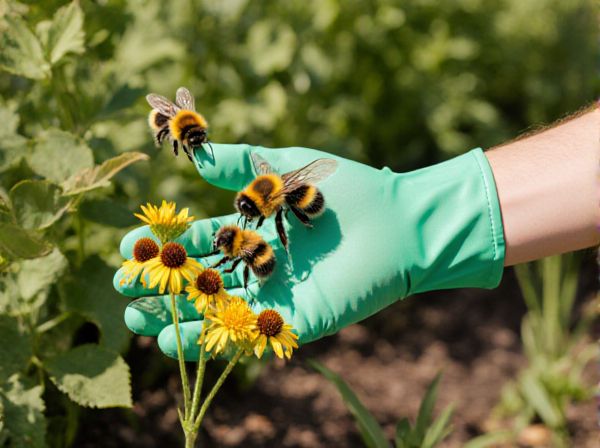
Gardening for Bees vs Gardening for Birds Illustration
Gardening for bees prioritizes planting a variety of native flowering plants that provide nectar and pollen throughout the growing season, creating a habitat that supports pollinator health and biodiversity. In contrast, gardening for birds often involves incorporating shrubs and trees that produce berries and seeds, as well as providing water sources and nesting sites to attract different bird species. Both approaches enhance ecosystem balance but require distinct plant selections and garden designs to meet the specific needs of pollinators or avian visitors.
Table of Comparison
| Aspect | Gardening for Bees | Gardening for Birds |
|---|---|---|
| Main Pollinators | Honeybees, Bumblebees, Solitary Bees | Birds (Hummingbirds, Finches) |
| Primary Focus | Flower-rich plants with nectar and pollen | Fruit-bearing plants, seeds, and nectar-rich flowers |
| Plant Types | Native wildflowers, herbs, flowering shrubs | Berry bushes, seed plants, tubular flowers |
| Water Sources | Shallow water dishes, damp soil | Birdbaths, water fountains |
| Habitat Needs | Bee hotels, undisturbed soil, natural nesting sites | Dense shrubs, trees, birdhouses |
| Seasonal Considerations | Continuous bloom from spring to fall | Fruit availability and seasonal seed production |
| Pesticide Use | Avoid chemical pesticides to protect bees | Limit pesticide use to protect birds and insect food sources |
Understanding the Needs of Bees and Birds in Your Garden
Gardening for bees requires planting native flowering plants that provide abundant nectar and pollen throughout the growing season, ensuring continuous food sources and habitat for pollinators. Birds benefit from diverse plantings that include shrubs and trees offering shelter, nesting sites, and seeds or berries for sustenance. Understanding the distinct dietary and habitat needs of bees and birds allows gardeners to create a balanced ecosystem that supports pollination and wildlife biodiversity.
Essential Plants for Attracting Bees vs Birds
Essential plants for attracting bees include native wildflowers, lavender, and coneflowers, which provide abundant nectar and pollen critical for bee health and reproduction. In contrast, gardening for birds often features berry-producing shrubs, sunflowers, and seed-bearing plants that supply vital food resources and nesting materials. Incorporating a diversity of these plants supports both pollinator and avian populations, enhancing garden biodiversity and ecosystem resilience.
Designing Garden Layouts for Pollinator Diversity
Designing garden layouts to support pollinator diversity involves incorporating a variety of flowering plants that bloom at different times, providing continuous nectar and pollen sources for bees and birds alike. Creating layered vegetation with native shrubs, herbaceous plants, and ground covers offers diverse habitats that cater to the foraging preferences and nesting needs of both pollinators. Incorporating water sources and minimizing pesticide use further enhances the garden's suitability for sustaining healthy populations of bees and birds.
Differences in Nesting and Shelter for Bees and Birds
Gardening for bees requires providing specific nesting habitats such as bare soil patches, woody stems, and bee hotels to support solitary and ground-nesting species. In contrast, gardening for birds emphasizes planting dense shrubs, trees, and installing birdhouses or nesting boxes to offer shelter and breeding sites. Understanding these differences in nesting and shelter needs helps create targeted environments that promote diverse and healthy pollinator populations.
Water Sources: What Bees and Birds Require
Bees require shallow water sources with landing spots like stones or floating materials to safely access hydration without drowning. Birds need deeper water for drinking and bathing, such as birdbaths or small ponds with gentle slopes. Providing diverse water features tailored to these needs supports healthy pollinator and bird populations in gardens.
Natural Pest Control by Bees and Birds
Gardening for bees enhances natural pest control by promoting pollination and attracting beneficial insects that prey on harmful pests. Birds contribute to pest management by feeding on caterpillars, beetles, and other insects, reducing the need for chemical pesticides. Combining both strategies creates a balanced ecosystem that supports pollination and biologically controls pest populations effectively.
Avoiding Harmful Pesticides for Pollinator Safety
Avoiding harmful pesticides is crucial for protecting both bees and birds in pollinator-friendly gardens. Using organic or natural pest control methods preserves the health of native bee populations and bird species by minimizing exposure to toxic chemicals. Creating pesticide-free habitats with diverse flowering plants ensures safer environments that support pollination and biodiversity.
Seasonal Garden Care for Bees and Birds
Seasonal garden care for bees involves planting native flowering plants that bloom in early spring through late fall, ensuring continuous nectar and pollen sources. For birds, seasonal care includes providing a variety of shrubs and fruit-bearing plants for shelter and food throughout different seasons, especially during winter months. Both pollinators benefit from pesticide-free zones and water sources maintained year-round to support their health and activity.
Creating a Pollinator-Friendly Habitat: Bees vs Birds
Creating a pollinator-friendly habitat involves selecting plants that provide abundant nectar and pollen essential for bees' nutrition and pollination activities, emphasizing native flowering species like coneflowers, milkweed, and lavender. Bird-friendly gardening prioritizes fruiting shrubs, seed-producing plants, and trees that supply food and shelter, such as serviceberry, dogwood, and sunflowers, supporting birds' feeding and nesting requirements. Integrating diverse plant structures and bloom times ensures prolonged resources for both bees and birds, maximizing ecological benefits within garden ecosystems.
Long-Term Benefits of Diverse Pollinator Gardening
Gardening for bees supports the health of native pollinator populations essential for crop production and biodiversity, enhancing ecosystem resilience over time. In contrast, gardening exclusively for birds may limit pollination services, as many bird species do not contribute directly to plant fertilization. Diverse pollinator gardening promotes long-term sustainability by providing varied habitats and food sources, ensuring balanced ecological interactions and improved plant reproduction rates.
Gardening for Bees vs Gardening for Birds Infographic

 gardendif.com
gardendif.com